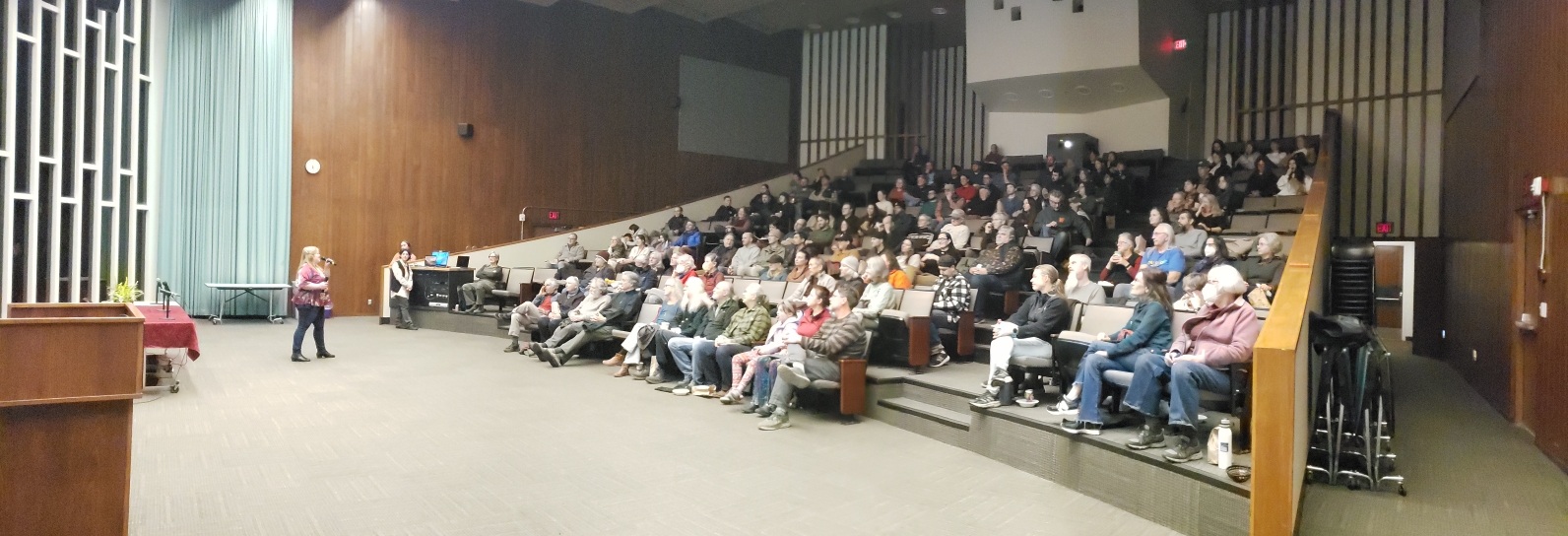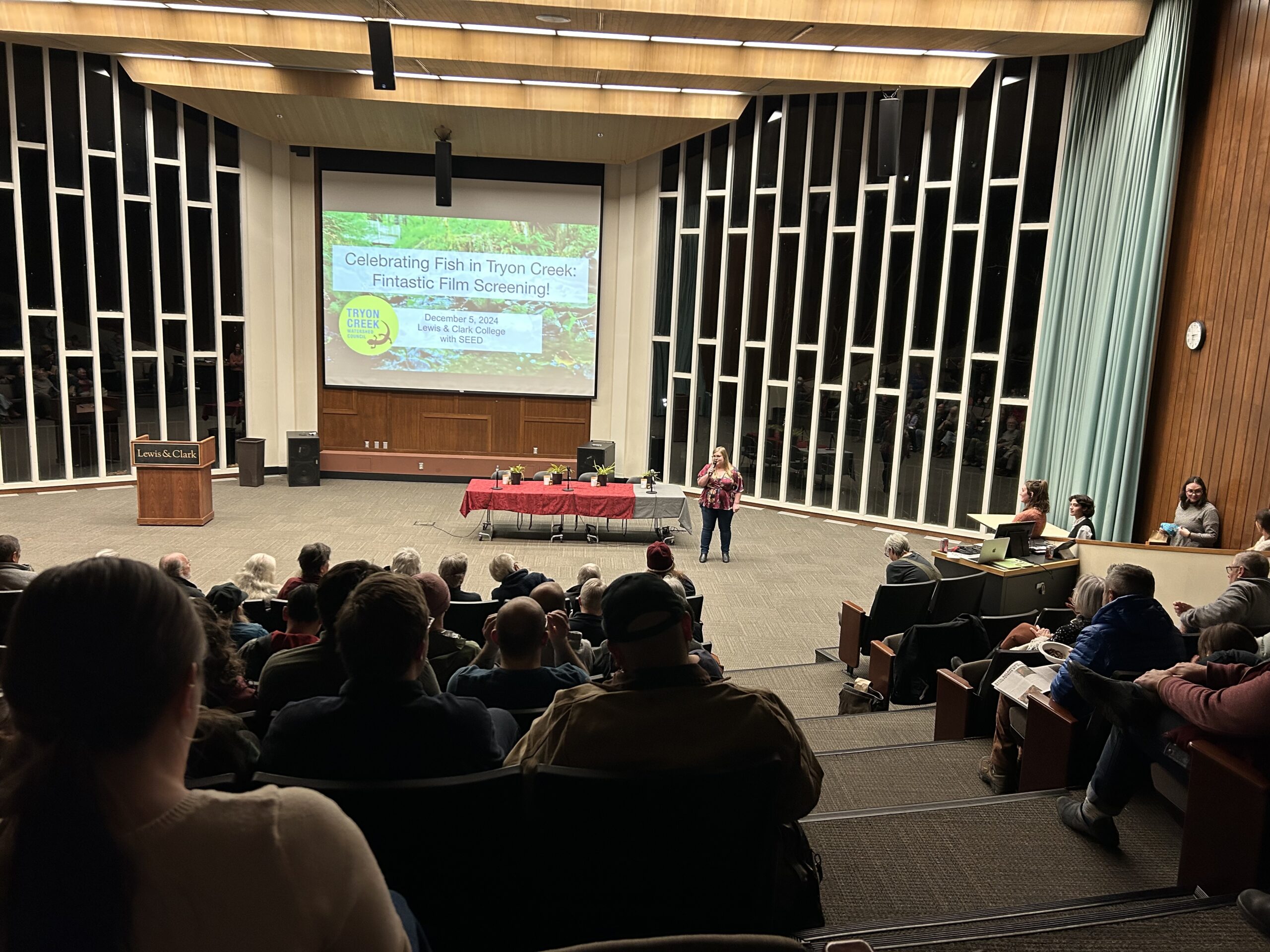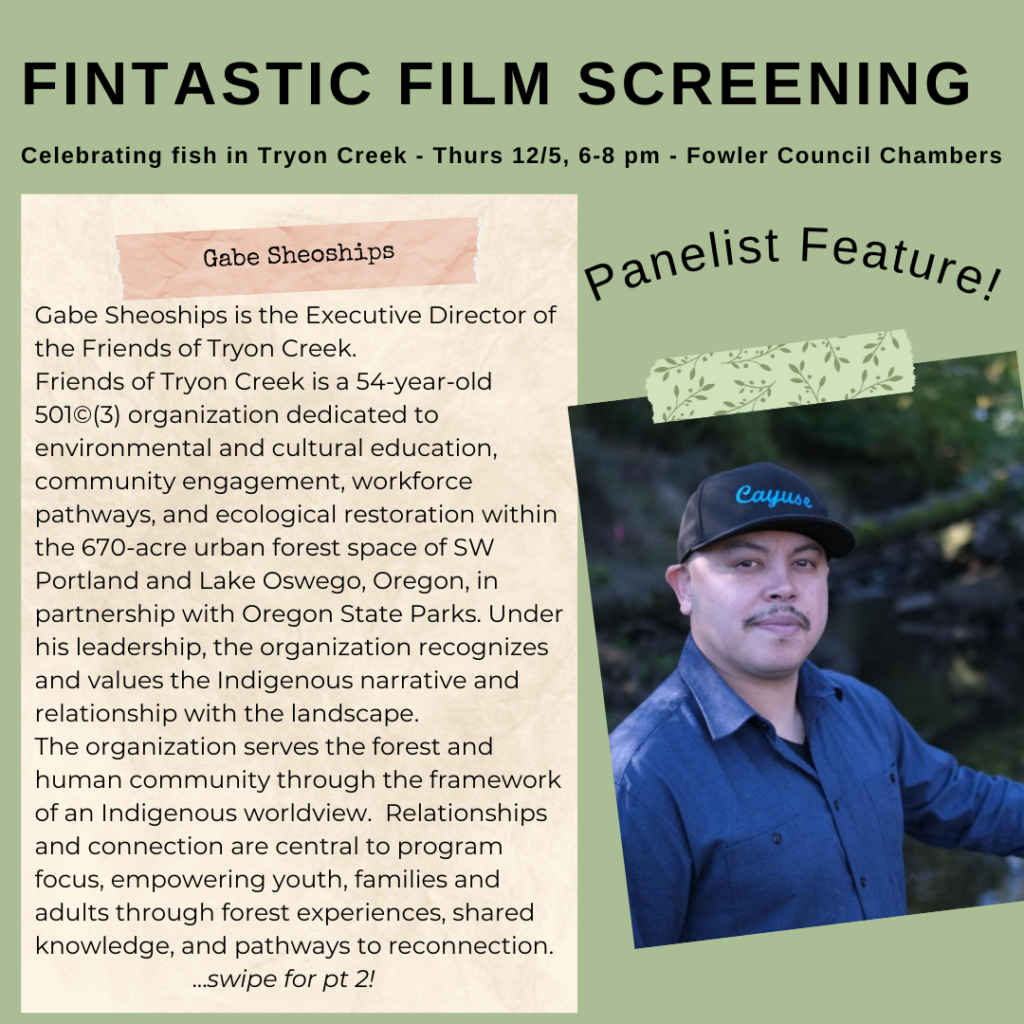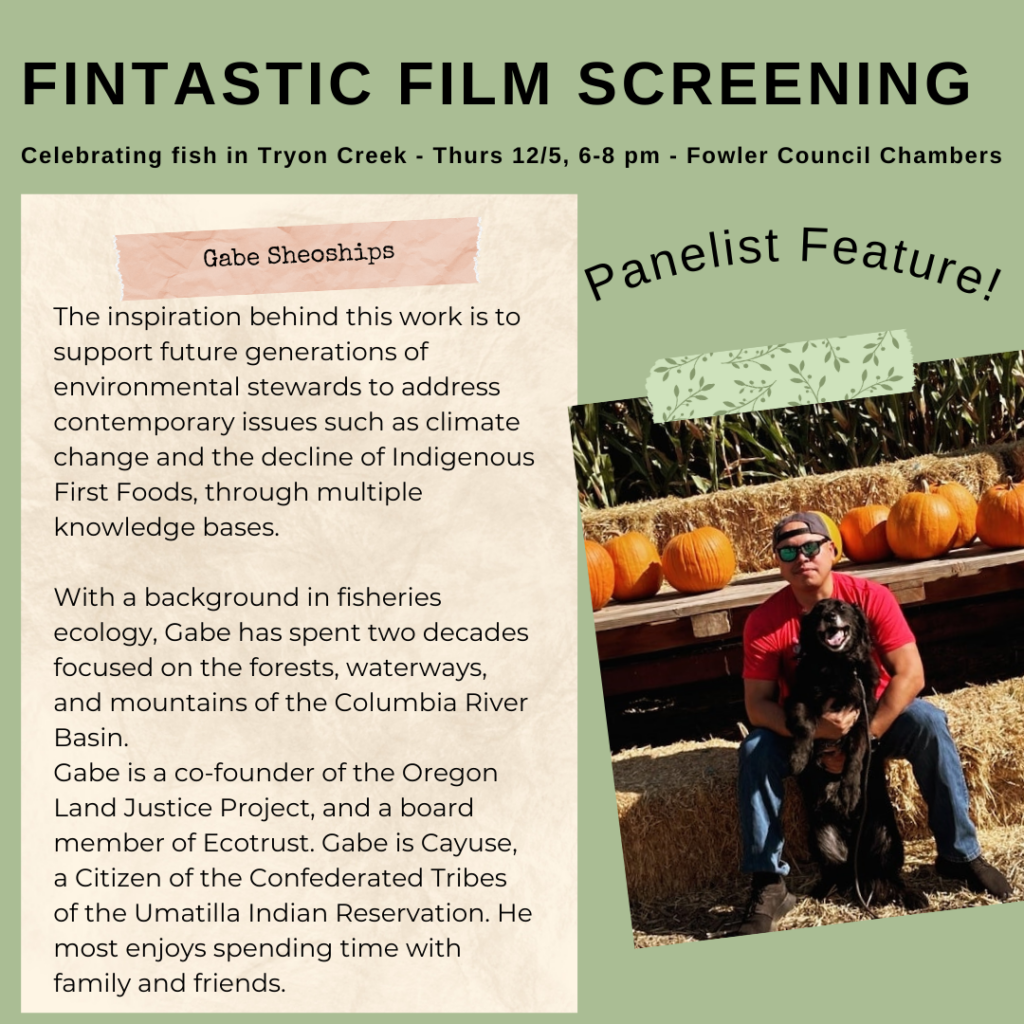Fintastic Film Screening, a celebratory gathering
Celebrating Fish in Tryon Creek: Fintastic Film Screening was hosted by Tryon Creek Watershed Council and SEED at Lewis and Clark College, and was well-attended by community members as well as Lewis & Clark College students.
This celebratory and educational event showcased a few special films to highlight efforts to honor and support native migratory fish, and was followed by a panel. By co-hosting with SEED (Students Engaged in Eco Defense), TCWC was able to rent the Council Chamber room of the Fowler Student Center. In the foyer outside of the room, several tables were set up providing food and drinks (including a popcorn bar with assorted sweet and savory mix-ins!), as well as tables and posters from various partners (listed below). As 6pm approached, attendees made their way inside to the auditorium.
TCWC’s Executive Director, Alexis Barton Castro, welcomed attendees to the event with an introduction to and overview of watersheds and the role Tryon Creek plays for migratory fish: The stretch of the Willamette River in the Portland metropolitan area is relatively simple, and cold water refuge habitat at tributary junctions with the Willamette River are a limiting factor for ESA-listed Clackamas salmon populations. Tryon Creek provides this cool refuge, and is 12* F colder than the Willamette River in the summertime – this means it provides important stepping stone habitat for salmon and other native migratory fish that move up into the Willamette River basin.
The first film shown was by Freshwaters Illustrated, titled PLACE: People, Lamprey, and Cultural Ecology. This beautiful short film featured Friends of Tryon Creek’s Executive Director, Gabe Sheoships, and can be viewed at this link (8 minutes). You can learn more about Pacific Lamprey in a longer Freshwaters Illustrated film called the Lost Fish, viewed at this link (24 minutes).
The two subsequent films shown were developed by TCWC and our summer Sustainability Intern through Lewis & Clark College, Jess Gustafson (’25). The first celebrates a large fish passage barrier removal project was completed in the Tryon Creek watershed in the last few years – formerly the Boones Ferry Culvert, now the Boones Ferry Bridge allows better, safe passage for fish, wildlife, and pedestrians alike, near where Arnold Creek flows into Tryon Creek just between Marshall Park and Tryon Creek State Natural Area. This project has been celebrated unofficially and internally, but not at a public event. Jess’ film elevated this meaningful project and included interviews from staff at the Bureau of Environmental Services: Melissa Brown, Senior Fish Biologist, Christa von Behren, Natural Resources Ecologist, and Ali Young, Capital Projects Manager, who were all involved in work before, during, and after this project’s implementation. You can watch the 25-minute video on YouTube here.
The third film focused on the Highway 43 Culvert Project, the singly most important fish passage barrier now remaining in the Tryon Creek watershed. Tryon Creek Watershed Council has long advocated for the replacement of this barrier to allow access for migratory salmon and other fish into the healthy habitat that the Tryon Creek watershed provides. The additional interview with Melissa Brown was filmed on-site at the confluence of Tryon Creek with the Willamette River, and discussed the history of improvements to the culvert and the role that Tryon Creek plays for migratory fish both at the confluence downstream of the culvert, as well as the potential for upper watershed habitat access that the replacement of the culvert would provide. This film also included drone footage of the Highway 43 and Tryon Creek/Willamette River confluence area, some capturing beautiful fall foliage. You can view the 11-minute video on YouTube here.
TCWC will keep community members informed of updates to the Highway 43 Culvert project; the US Army Corps of Engineers is the project lead, and City of Portland Bureau of Environmental Services (BES) is the non-federal sponsor.
After the films, a panel featured Gabe, Melissa, Christa, and Lewis & Clark College’s Dylan Carlson, Forest Conservationist & Grounds Staff. TCWC is working more closely with Lewis & Clark College including through facilitating a Watershed Conservation Activities P.E. class in coordination with Dylan (end-of-term writeup here!).
Below are the panelists’ bios (in slideshow or text form) and an explanation of the tremendous thank-you’s that go out to TCWC’s Board members and partners who helped make this event possible.
Thank you to Sylvia Barclay (’25), LC Student Representative on the TCWC Board. Her leadership made this event possible, including as President of SEED in securing the venue, co-hosting, and donating $200 towards food for attendees; and in publicizing the event, managing on-campus department logistics, and day-of errands & set-up.
Thank you to Jess Gustafson (’25), for their work this summer and ongoing dedication and support in editing the videos and trimming them down for this event, and helping run the screen/IT during the event. This event wouldn’t have been conceptualized without Jess’ interest in developing films to celebrate Boones Ferry Bridge and elevate knowledge about the Hwy 43 culvert!
Thank you to TCWC Board members Megan Hill, Rebecca Crosby & son Brewster (phenomenal drone footage), Jill Gaddis, Sharon Keast, Danielle Goodrich, and Terri Preeg Riggsby, for helping make things come together so smoothly, including though groceries and donations and day-of set-up. Danielle prepared over a hundred bags of popped popcorn for the popcorn bar! Gifts to panelists included locally harvested tea (Megan), honey (harvested on Lewis & Clark College by SEED), and Bosky Dell deer ferns (Terri). This was really a team effort and could not have happened without many peoples’ support!
A final thank-you is owed to our great partners who tabled in the foyer as people enjoyed snacks and drinks before heading into the Council Chamber room: Friends of Tryon Creek, Westside Watershed Resource Center and Stormwater Stars, and Bureau of Environmental Services; and, to BES for funding our Science Talk programming which this was a spin on.
Panelists:
Melissa Brown: After a 1996 tour for the National Marine Fisheries Service (NMFS) in the Bering Sea, Melissa realized that fisheries were more than just fish. It became apparent that a complex mix of history, politics, and conservation was integral to management decisions that shape future abundance and distribution, and that a biologist working for species recovery should be versed in all three.
After working for the Lummi Nation to restore river habitat in northern Puget Sound, Melissa moved to Portland in 2010 to serve the City as the senior fish biologist for the Bureau of Environmental Services. For the last 15 years, she has worked in the Tryon Creek watershed to recover habitat-forming processes that will benefit the restoration and conservation of its native species.
Dylan Carlson: Dylan Carlson works for Grounds at Lewis & Clark College with an interest in environmental restoration & conservation and water quality, both from his academic background and traditional ideas and ways. His degree is in Forestry with a focus on Forest Health and Pathology from Northern Arizona University. Dylan has been engaged in this type of work for the past 15 years with conservation districts, elementary schools, and private contractors.
Growing up in Northern Arizona and being a member of the Hopi Tribe and in the Sun Clan, Dylan has a spiritual and moral obligation to care for and steward the earth. Outside of work he likes to make art with film photography and screen printing, ride bikes, and generally be outdoors.
Gabe Sheoships: Gabe Sheoships is the Executive Director of the Friends of Tryon Creek. Friends of Tryon Creek is a 54-year-old 501(c)(3) organization dedicated to environmental and cultural education, community engagement, workforce pathways, and ecological restoration within the 670-acre urban forest space of SW Portland and Lake Oswego, Oregon, in partnership with Oregon State Parks. Under his leadership, the organization recognizes and values the Indigenous narrative and relationship with the landscape. The organization serves the forest and human community through the framework of an Indigenous worldview. Relationships and connection are central to program focus, empowering youth, families and adults through forest experiences, shared knowledge, and pathways to reconnection. The inspiration behind this work is to support future generations of environmental stewards to address contemporary issues such as climate change and the decline of Indigenous First Foods, through multiple knowledge bases.
With a background in fisheries ecology, Gabe has spent two decades focused on the forests, waterways, and mountains of the Columbia River Basin. Gabe is a co-founder of the Oregon Land Justice Project, and a board member of Ecotrust. Gabe is Cayuse, a Citizen of the Confederated Tribes of the Umatilla Indian Reservation. He most enjoys spending time with family and friends.
Christa von Behren: Christa began her exploration of Portland’s urban ecology during her career as a mudpie baker on the banks of Vermont and Woods Creeks in southwest Portland, where she grew up. She studied biology at Macalester College in St. Paul, Minnesota and then earned a PhD in Environmental Science and Resources from Portland State University. Christa has worked in various positions at the Bureau of Environmental Services since 2014. In her current role with the Revegetation – Natural Areas program she stewards natural areas in the Fanno, Stephens, and Tryon Creek watersheds of southwest Portland.














